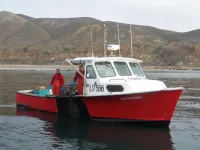(Press-News.org) You can't have your cake and eat it too, as the saying goes. But what if you could save your slice while enjoying the benefits at the same time? New research suggests this is possible when it comes to marine reserves.
Marine protected areas (MPAs) are among the best conservation tools at our disposal today. However, by their very nature, these reserves take away fishing grounds, which can make them unattractive to commercial fishermen. Scientists and resource managers often promote MPAs as beneficial for the fishery. In theory, they provide a refuge for stocks to rebuild and spill over into nearby waters, leading to improved catch rates.
"And yet, there's a lot of skepticism about that because there aren't many instances where anyone's ever shown that to be true," said Dan Reed(link is external), a research biologist at UC Santa Barbara's Marine Science Institute.
Most of the work so far has documented the buildup of species populations within reserves and the subsequent spillover. "What hasn't been documented is how that actually affects the catch," he continued. Namely, whether any increase in catch from spillover actually compensates for the loss of fishing grounds.
Reed and his colleague Professor Hunter Lenihan(link is external), a professor at UCSB's Bren School of Environmental Science & Management, along with other researchers at UC Santa Barbara and the California Department of Fish and Wildlife, sought to determine to what extent the spillover effect compensated for the fishing grounds incorporated into marine reserves. To this end, they leveraged catch reports from lobster fishermen as well as scientific surveys. Their results, published in Scientific Reports(link is external), affirm the benefits that MPAs confer to fisheries and ecosystems.
"The key question is what is the net effect of the reserves on the fishery?" proposed lead author Lenihan, a fisheries ecologist. "If you take away a certain amount of territory, do you make up for it by this increase in catch through spillover?"
"What we found is that you not only make up for the lost area, but actually enhance the fishery," replied Reed.
The team compared lobster populations and catch records from waters off the coast of Santa Barbara and Goleta. From 2012 through 2018, divers conducted surveys of the size and abundance of lobsters at five sites studied by the Santa Barbara Coastal Long Term Ecological Research program (SBC LTER), which is part of the National Science Foundation's LTER network. Three of these reefs have always been open to fishing, while two of them (Isla Vista and Naples reefs) were incorporated into two marine reserves in 2012.
The researchers also obtained data for commercial landings and fishing effort -- measured in the number of traps pulled -- from the California Department of Fish and Wildlife, which manages the state's fisheries. Records from six years before and after the establishment of the two MPAs gave the scientists a sizable window to examine the impact that the reserves had on the lobster catch. The department divides the coast into rectangular fishing blocks, and these became the spatial units the researchers used in the study.
The team observed that the number and overall biomass of lobsters increased in and around the marine reserves once fishing was prohibited. This suggested that lobsters were indeed proliferating inside the reserves and spilling out into surrounding areas, just as predicted by the theory.
They also found that annual lobster landings more than doubled in the fishing block with the two MPAs during the six years after their establishment despite the 35% reduction in fishing area in that block. In contrast, the annual catch in blocks without MPAs remained relatively unchanged over that timespan.
"This study is one of the first to quantify and document that the establishment of marine reserve actually enhanced catch despite reducing the area that fishermen could actually fish," said Reed.
Records indicate that a roughly 225% increase in catch near marine reserves was accompanied by a 250% increase in fishing activity; however, the researchers note that this isn't merely a case of laying more traps and catching more lobsters. The increased effort was targeted largely near the borders of the reserves as fishermen "fished the line" to target lobsters that spilled over from the reserves into fishable areas. "Without spillover from a reserve, increasing fishing effort is much less likely to result in increased catch," said Reed.
"Our data suggest that in the case of lobster the MPAs have the potential to lead to a higher sustainable catch," he concluded.
Lenihan and Reed were quick to point out that studies like this are possible largely thanks to projects like the SBC LTER. The sustained funding from the NSF enables scientists to curate rich timeseries datasets they can use to investigate questions that involve relatively long timespans.
The researchers at the SBC LTER have worked with the local fishing communities for years in an effort to understand the effects of reserves. Their collaboration with the California Lobster and Trap Fishermen's Association has been particularly fruitful, Lenihan said. Lobstermen Chris Miller, Sam Shrout and Chris Voss dedicated substantial time to train Bren School doctoral students Matt Kay, in 2006, and Sean Fitzgerald, in 2018, to trap lobsters like professionals, thus assuring collection of excellent fisheries data. In addition, scientists hopped aboard commercial fishing boats to trap lobsters with the fleet.
They've also relied on fishermen for data. After tagging some 17,000 lobsters with researchers' names and phone number, the scientists waited for fishermen to report where the lobsters were caught. This provided insight into the animals' movements that would not have been possible without such a collaboration.
Lobstermen also appear to be benefiting from this relationship. Reserves seem to have increased landings in the northern extent of the fishery much more than in the south. Lenihan and Reed suspect this is because the fishermen in the north have been working with the scientists, giving them access to insights that their southern counterparts don't have.
"We learn from them; they learn from us," Lenihan said.
"Collaboration between researchers and fishermen not only serves their interests, but it can also really benefit the conservation value of the MPAs and the resource agencies charged with managing them," added Reed.
Cooperation between scientists, fishermen and resource managers leads to better information, more transparency and more trust, Lenihan explained. Ultimately, that improves science, management, conservation and fishing.
INFORMATION:
The study's other coauthors include Associate Professor Adrian Stier and graduate students Jordan Gallagher and Joseph Peters in the Department of Ecology, Evolution, and Marine Biology, as well as Jennifer Hofmeister of the California Department of Fish and Wildlife.
More fully appreciating family and engaging in more conflict are among the heightened experiences during the coronavirus pandemic, according to a new UC Riverside study.
The study from David Funder's psychology lab looked at how people experience everyday life and its situations and how those experiences change because of an extraordinary event - the global pandemic.
Undergraduate students took part in the study, which first collected responses from 544 of them in 2017, and then from 123 students during the pandemic in spring 2020, when most of the participants were sheltering at home.
The before-and-during comparison isn't all roses for pandemic living. Some everyday experiences suffer, such as conversation, finding ...
The American College of Cardiology's Cardiovascular Summit will feature several poster presentations on care delivery, cost reduction and quality improvement that offer innovative concepts to combat access to care, especially during the ongoing COVID-19 pandemic and as the broader health care system works to improve health equity. Research examines the rapid adoption of virtual outpatient care, enabling rural primary care teams to improve cardiovascular health and optimizing emergency room use after clinic hours.
Summaries of embargoed abstracts are below. For access to the full abstracts ...
When it comes to developing drugs for mental illnesses, three confounding challenges exist:
Men and women experience them differently, with things like depression and anxiety far more common in females.
A drug that works for one person may not work for another, and side effects abound.
New CU Boulder research, published in the journal eLIfe, sheds light on one reason those individual differences may exist. Turns out a key protein in the brain called AKT may function differently in males than females.
The study also offers a closer look at where, precisely, in the brain things may go ...
Every late winter and early spring, huge dust storms swirled across the bare and frozen landscapes of Europe during the coldest periods of the latest ice age. These paleo-tempests, which are seldom matched in our modern climate frequently covered Western Europe in some of the thickest layers of ice-age dust found anywhere previously on Earth. This is demonstrated by a series of new estimates of the sedimentation and accumulation rates of European loess layers obtained by Senior Research Scientist Denis-Didier Rousseau from Ecole Normale Supérieure in Paris, France, and colleagues. The work, which is published in Quaternary Science Reviews is part of the TiPES project on tipping points in the Earth system, coordinated by The University ...
LA JOLLA--(February 1, 2021) Wolffia, also known as duckweed, is the fastest-growing plant known, but the genetics underlying this strange little plant's success have long been a mystery to scientists. Now, thanks to advances in genome sequencing, researchers are learning what makes this plant unique--and, in the process, discovering some fundamental principles of plant biology and growth.
A multi-investigator effort led by scientists from the Salk Institute is reporting new findings about the plant's genome that explain how it's able to grow so fast. The research, published in the February 2021 issue of Genome Research, will help scientists to understand how plants make trade-offs between ...
DALLAS, Feb. 1, 2021 -- Women with a history of diabetes during pregnancy (gestational diabetes) are twice as likely by mid-life to develop calcium in heart arteries - a strong predictor of heart disease - even if healthy blood sugar levels were attained many years after pregnancy, according to new research published today in the American Heart Association's flagship journal Circulation.
Gestational diabetes, which is high blood sugar levels (glucose intolerance) first recognized during pregnancy, affects approximately 9% of U.S. pregnancies and up to 20% worldwide. After pregnancy, women who had gestational diabetes are at higher risk of developing prediabetes or Type 2 diabetes, conditions that are risk factors ...
Irvine, Calif. -- Researchers from the University of California, Irvine and the University of Minnesota have found that an enriched diet and companionship can reduce pain in mice with sickle cell disease by increasing serotonin. They also discovered that duloxetine, an antidepressant that boosts serotonin levels, could be an alternative to opioids in treating chronic pain.
"Finding safe and effective alternatives to opioids is a research priority, especially for patients with sickle cell disease," said Dr. Keith Hoots, director of the Division of Blood Diseases and Resources at the National Heart, Lung, and Blood Institute. "It's encouraging to see a dose-response relationship to nutrients and companions in mice, ...
ROCHESTER, Minn. -- Researchers from Mayo Clinic and AliveCor Inc. have been using artificial intelligence (AI) to develop a mobile device that can identify certain patients at risk of sudden cardiac death. This research has yielded a breakthrough in determining the health of the electrical recharging system in a patient's heart. The researchers determined that a smartphone-enabled mobile EKG device can rapidly and accurately determine a patient's QTc, thereby identifying patients at risk of sudden cardiac death from congenital long QT syndrome (LQTS) or drug-induced QT prolongation.
The heart beats by a complex system of electrical signals triggering regular and necessary contractions. Clinicians evaluate the heart's rate-corrected QT interval, or QTc, as a vital ...
An underused type of knee surgery in younger patients, called high tibial osteotomy, shows considerable success in reducing the need for total knee replacement, according to new research in CMAJ (Canadian Medical Association Journal).
"High tibial osteotomy is a knee surgery aimed at younger patients in the earlier stages of knee osteoarthritis. One of its goals is to prevent or delay the need for knee replacement," says coauthor Dr. Trevor Birmingham, Canada Research Chair in the Faculty of Health Sciences and the Bone and Joint Institute at Western University, London, Ontario. "In some ways, it's like performing ...
A calculation so complex that it takes twenty years to complete on a powerful desktop computer can now be done in one hour on a regular laptop. Physicist Andreas Ekström at Chalmers University of Technology, together with international research colleagues, has designed a new method to calculate the properties of atomic nuclei incredibly quickly.
The new approach is based on a concept called emulation, where an approximate calculation replaces a complete and more complex calculation. Although the researchers are taking a shortcut, the solution ends up almost exactly the same. It is reminiscent of algorithms ...



